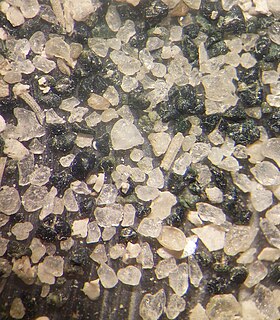
Back جلوكونيت Arabic Qlaukonit Azerbaijani Глаўканіт Byelorussian Glauconita Catalan Glaukonit German Glauconita Spanish Glaukoniit Estonian Glaukonita Basque Glauconite French Glauconita Galician
| Glauconite | |
|---|---|
 Glauconite pellets and small fossils among quartz grains in greensand from the Dutch Pliocene | |
| General | |
| Category | Phyllosilicate |
| Formula (repeating unit) | (K,Na)(Fe,Al,Mg)2(Si,Al)4O10(OH)2 |
| IMA symbol | Glt[1] |
| Crystal system | Monoclinic |
| Crystal class | Prismatic (2/m) (same H-M symbol) |
| Space group | C2/m |
| Unit cell | a = 5.234 Å, b = 9.066 Å, c = 10.16 Å; β = 100.5°; Z = 2 |
| Identification | |
| Color | Blue green, green, yellow green |
| Crystal habit | Elastic platy/micaceous, or as rounded pellets/aggregates |
| Cleavage | Perfect [001] |
| Mohs scale hardness | 2 |
| Luster | Dull, earthy |
| Streak | Light green |
| Diaphaneity | Translucent to nearly opaque |
| Specific gravity | 2.4–2.95 |
| Optical properties | Biaxial (-); moderate relief |
| Refractive index | nα = 1.590 – 1.612 nβ = 1.609 – 1.643 nγ = 1.610 – 1.644 |
| Birefringence | δ = 0.020 – 0.032 |
| Pleochroism | X = yellow-green, green; Y = Z = deeper yellow, bluish green |
| Other characteristics | loosely bound aggregates, crumbles radioactivity: barely detectable |
| References | [2][3][4] |
Glauconite is an iron potassium phyllosilicate (mica group) mineral of characteristic green color which is very friable[5] and has very low weathering resistance.
It crystallizes with a monoclinic geometry. Its name is derived from the Greek glaucos (γλαυκός) meaning 'bluish green', referring to the common blue-green color of the mineral; its sheen (mica glimmer) and blue-green color. Its color ranges from olive green, black green to bluish green, and yellowish on exposed surfaces due to oxidation. In the Mohs scale it has a hardness of 2, roughly the same as gypsum.[6] The relative specific gravity range is 2.4–2.95. It is normally found as dark green rounded concretions with the dimensions of a sand grain. It can be confused with chlorite (also of green color) or with a clay mineral. Glauconite has the chemical formula (K,Na)(Fe,Al,Mg)2(Si,Al)4O10(OH)2.
Glauconite particles are one of the main components of greensand, glauconitic siltstone and glauconitic sandstone. Glauconite has been called a marl in an old and broad sense of that word. Thus references to "greensand marl" sometimes refer specifically to glauconite. The Glauconitic Marl formation is named after it, and there is a glauconitic sandstone formation in the Mannville Group of Western Canada.
- ^ Warr, L.N. (2021). "IMA–CNMNC approved mineral symbols". Mineralogical Magazine. 85 (3): 291–320. Bibcode:2021MinM...85..291W. doi:10.1180/mgm.2021.43. S2CID 235729616.
- ^ Handbook of Mineralogy
- ^ Webmineral
- ^ Mindat
- ^ Odin, G.S. (ed., 1988). Green marine clays. Development in sedimentology, 45. Elsevier, Amsterdam.
- ^ "Mohs Hardness Scale: Testing the Resistance to Being Scratched". geology.com. Retrieved 2024-04-10.